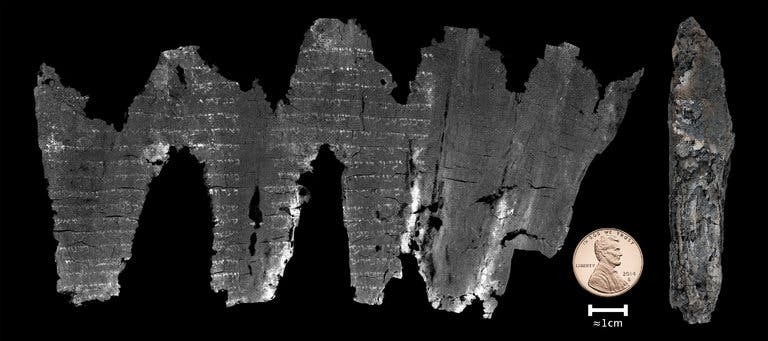
Scientists have unraveled the secrets of a 1,700-year-old scroll too old and damaged to unfurl.
“We’re reading a real scroll,” lead study author Brent Seales, professor and chairman in the department of computer science at the University of Kentucky, said in a news conference yesterday (Sept. 20). “It hasn’t been read for millennia. Many thought it was probably impossible to read.”
In the 1970s, archaeologists unearthed an ancient synagogue at Ein Gedi, in today’s Israel. The place had hosted a large Jewish community from about 800 BCE until a huge fire devastated the community in about 600 CE. The fire destroyed most of the synagogue as well as the scrolls it held. When touched, the scrolls perished and reading them was thought to be impossible. So with the greatest of care, Jewish researchers locked the blackened scrolls away – until now.
Penina Shor at the Israel Antiques Authority spotted an opportunity and contacted computer scientist Brent Seales at the University of Kentucky to see if they have any way to peer inside the scroll. Seales had an idea – a technique called virtual unwrapping. It’s a delicate and painstaking process, but it can work.
“First we have to find the layers within the scanned volume. Finding evidence of those layers is called segmentation. So there’s a process for that. Once we find those layers we create a texture on those layers that comes from the scanned volume itself and that’s where the ink evidence gets situated onto the layered surface. And then the final step is this unwrapping where we flatten out that surface, which is not actually flat, it’s three dimensional. So that we can merge the pieces together and see the completely unwrapped scroll.”
They tried to apply this for the Ein Geidi scroll. When they first looked at the results… they didn’t really know what they were looking at. Seales can’t speak or read Hebrew, but he did realize it looks like writing. So they sent it back to the Jewish scholars, who obviously can.
“But I think the real joy came when Penina sent me back the result of having read our first results because then I knew that not only were we seen writing but it was readable because she and her team were able to identify it as a known text and at that point were absolutely jubilant I have to say.”
Archaeologists realized they were reading a scroll from Leviticus, one of the five books of Moses, the first five books of the Old Testament. This is one of the oldest biblical scrolls ever found, and in the end, it was clearly readable.
“Never in our wildest dreams did we think anything would come of it,” said Pnina Shor, the head of the Dead Sea Scrolls Project at the Israel Antiquities Authority.
They’re now hoping to apply the same technology to other burned scrolls.



